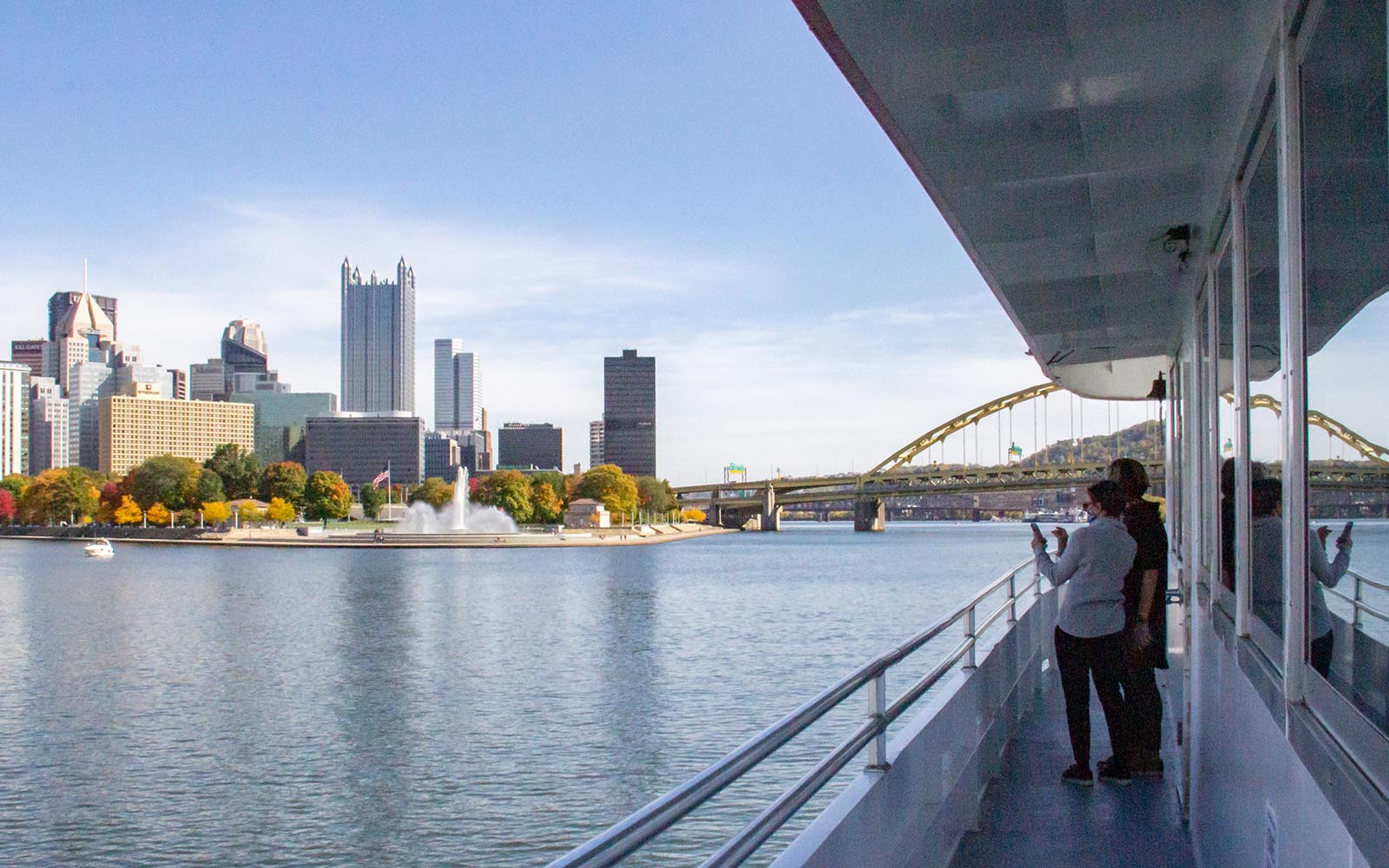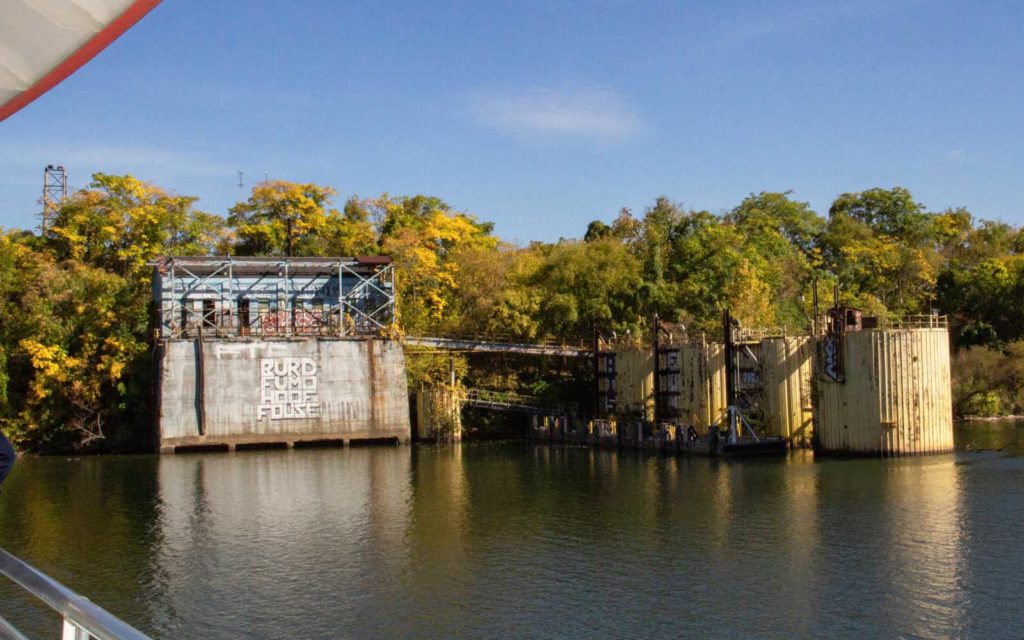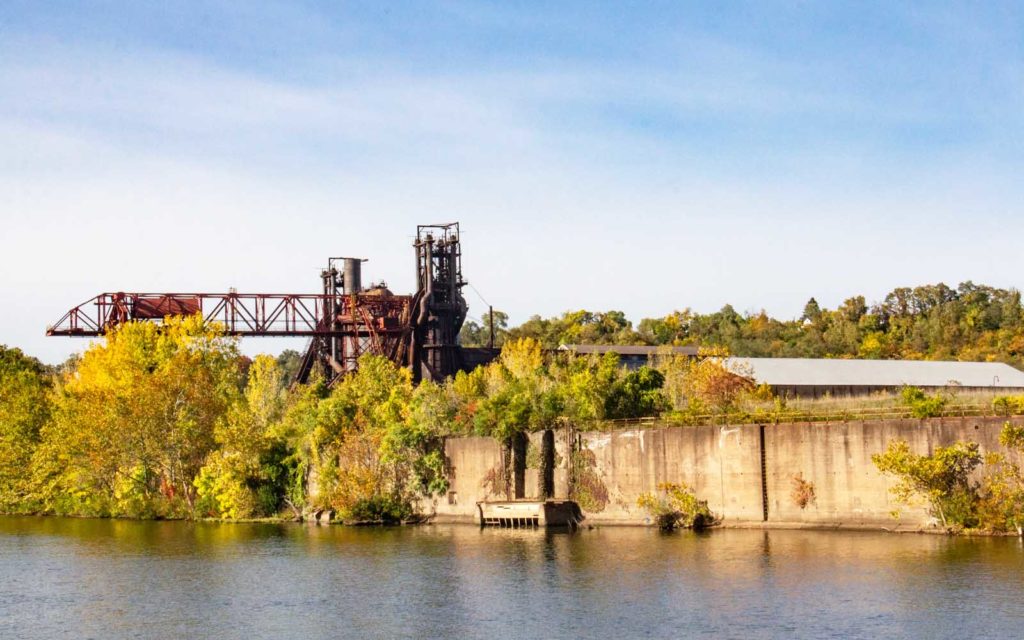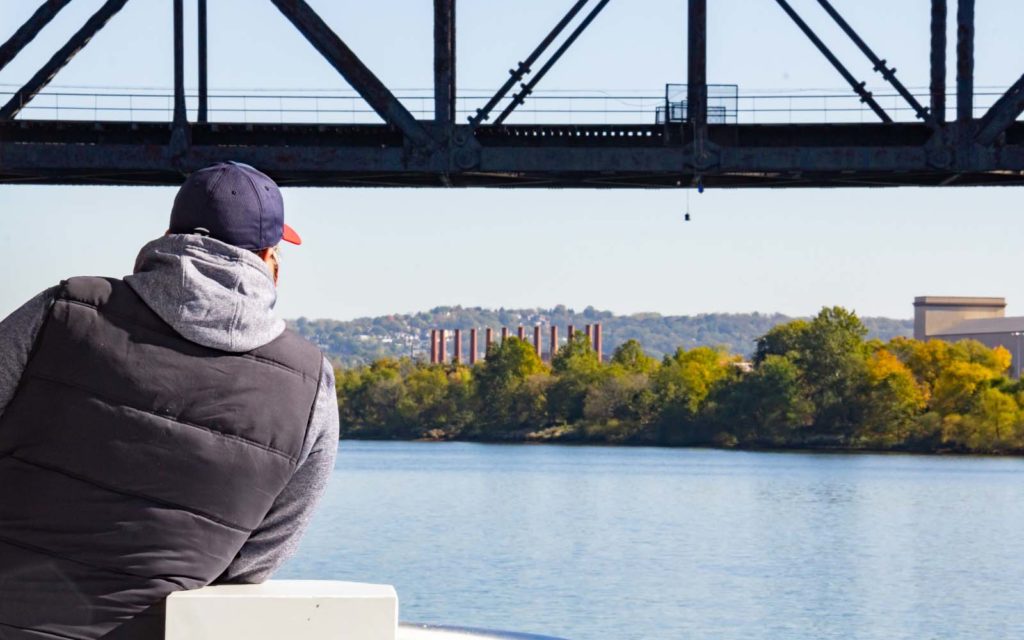
The Explorer riverboat approaches the Monongahela River during the Hardest Working River Tour, which was first offered last fall.
Getting to the Heart of the Hardest Working River
 Kirsten Paine, a tour guide and researcher with Rivers of Steel, reflects on the creation of The Hardest Working River Tour, a special boat tour of Pittsburgh’s Monongahela River being offered on the Explorer riverboat on May 15, 16, 22, & 23.
Kirsten Paine, a tour guide and researcher with Rivers of Steel, reflects on the creation of The Hardest Working River Tour, a special boat tour of Pittsburgh’s Monongahela River being offered on the Explorer riverboat on May 15, 16, 22, & 23.
By Kirsten Paine
I am a shy person. Introverted. I am easily overwhelmed in a crowd. I do not care for being the center of attention. I am a scholar of the 19th century, and I am very much a teacher. I enjoy talking to people. I like sharing stories, especially when those stories are old. My shelves at home are filled with old stories—novels, memoirs, poems, and plays. The best parts of my day occur when I can teach others about people, places, and events from two hundred years ago. Last fall I jumped at the opportunity to create a brand new tour for Rivers of Steel, one that makes some of those old stories reverberate in the 21st century.
As with just about every aspect of life, the COVID-19 pandemic shaped The Hardest Working River Tour. It has been a period of jarring disconnection, but I wanted the new tour to be all about connecting to the landscape shaped by the Monongahela River. I wanted to pull together the fragmented voices of black citizens who moved to Pittsburgh during the Great Migration in order to get factory jobs and let them set the stage for telling the story of industrial labor movements in the late 19th and early 20th centuries. I wanted to uncover a hidden cityscape by highlighting visible industrial remnants like empty barge moorings and decommissioned Bessemer converters. I wanted distant histories feel close, especially because we all needed to keep our distance from each other.

Industrial remnants on the Mon River near the Hazelwood Green site.
While researching material for the tour narrative, I needed a mix of big picture historical context as well as quirky, personal stories. The personal stories are the key to animating dates and statistics with life and purpose. Some visitors will disembark from the Explorer and remember barge tonnage or the date a factory opened. However, other visitors will go home and recall Jane Grey Cannon Swisshelm, an intrepid journalist, fierce abolitionist, and passionate women’s rights advocate who named the town of Swissvale. As visitors cruise past Carrie Furnaces, which sits partially in Swissvale, and see that mighty remnant of the Monongahela River’s industrial height, they hear about the woman reporter from Pittsburgh who worked to make her country a safer and more just place for marginalized people. The story is not really about how the land inherited a name; instead, the story is about a woman born more than two hundred years ago and how she just might have changed our lives.

The Carrie Blast Furnaces seen from the Explorer riverboat.
In addition to being the voice you hear from the speaker system on the Explorer, you might see me greeting visitors and leading tours at Carrie Blast Furnaces. And when I am not talking my way through iron-making history, I am a visiting lecturer in the English Department at the University of Pittsburgh. I have always found a deep sense of belonging in a classroom, and as a scholar who researches and writes about women’s writing in the Civil War era, I focus on ways to make 19th-century American literary culture accessible and useful to a 21st-century student body. My classroom is a space where assumptions of contemporary irrelevance are tested by the kinds of literature those assumptions are about, in this case 19th-century literature written by women. There are always unexpected moments of connection forged in lively discussions about narratives of lived and imagined experiences. It is so important, however, that such discussions also transpire beyond the walls, or the Zoom screens, of a classroom.
That is why some of the opening lines of The Hardest Working River are not mine. Instead, they belong to Rebecca Harding Davis, a writer born in Washington, Pennsylvania. She published a novella called Life in the Iron Mills in The Atlantic Monthly in 1861. While the story is set at a blast furnace in nearby Wheeling, West Virginia, the way Davis describes a 19th-century mill town just like Pittsburgh is choked, almost suffocating. She writes, “the idiosyncrasy of this town is smoke. It rolls sullenly in slow folds from the great chimneys of the iron-foundries, and settles down in black, slimy pools on the muddy streets. Smoke on the wharves, smoke on the dingy boats, on the yellow river,—clinging in a coating of greasy soot to the house-front, the two faded poplars, the faces of the passers-by.” As a foundational piece of American realism, Davis’ language evokes the kind of image one might see in a photograph. Her description is visceral, but it is also at odds with Pittsburgh in 2021. The smoke is gone. Buildings are no longer caked in black soot. The trees bloom in springtime and burst with color in the fall. People congregate near the river to run, walk, bike, boat, and fish. If we are really lucky, the skies are blue.
The heart of The Hardest Working River Tour explores the incongruity of those two images and tries to reconcile with the existence of two Pittsburghs—the lumbering powerhouse of 19th-century American industry and the quick, mobile vanguard of 21st-century modernity—from the perspective of the Monongahela River. The river becomes our vantage point, and from there, the pieces of Pittsburgh descending from neighborhoods nestled in the hills down to the businesses perched on the riverfront, become a classroom unlike any I have ever been in.

Viewing Homestead from the a vantage point on the Explorer.
I work for Rivers of Steel because publicly accessible and equitable educational opportunities are fun and ultimately serve the greater public good. Everyone I know at Rivers of Steel is committed to sustainable development through preservation and community outreach. Our communities benefit from resources where everyone has the chance to explore new ideas and learn from thoroughly researched and well-crafted programs. From my perspective, The Hardest Working River is a chance to give back to Pittsburgh in return for the personal and professional life it has made possible for me. I might not be a born and raised Pittsburgher, but I do feel like I can tap into the reservoir of complicated history and culture of this region and talk to people about why the Monongahela river valley is a rich source of stories from which we can all learn.
This article was published to coincide with the spring 2021 schedule of The Hardest Working River Tour on the Explorer riverboat.







